CHEVROLET S10 1996 2.G User Guide
Manufacturer: CHEVROLET, Model Year: 1996, Model line: S10, Model: CHEVROLET S10 1996 2.GPages: 375, PDF Size: 20.73 MB
Page 11 of 375
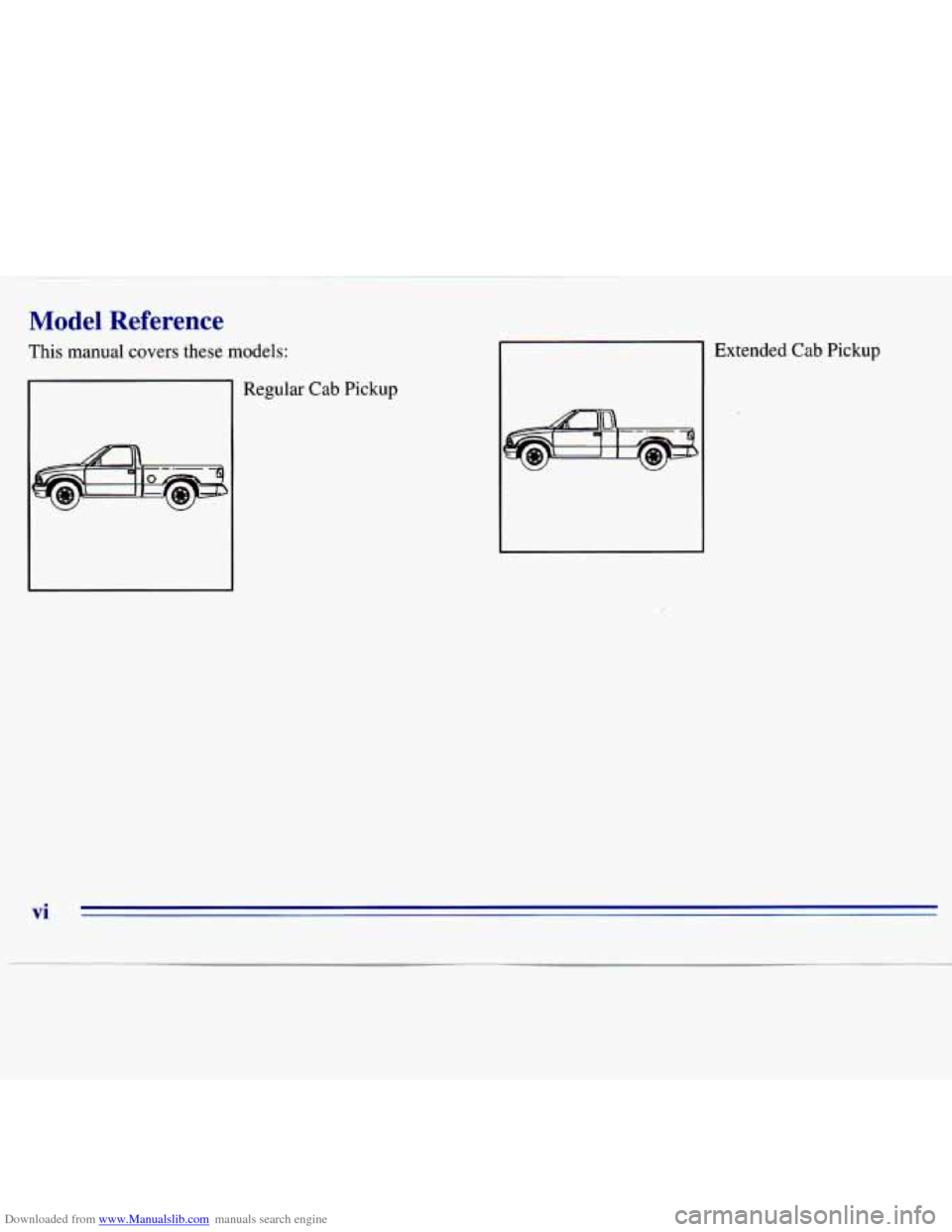
Downloaded from www.Manualslib.com manuals search engine Model Reference
This manual covers these models:
Regular Cab Pickup
I
Extended Cab Pickup
vi
Page 12 of 375
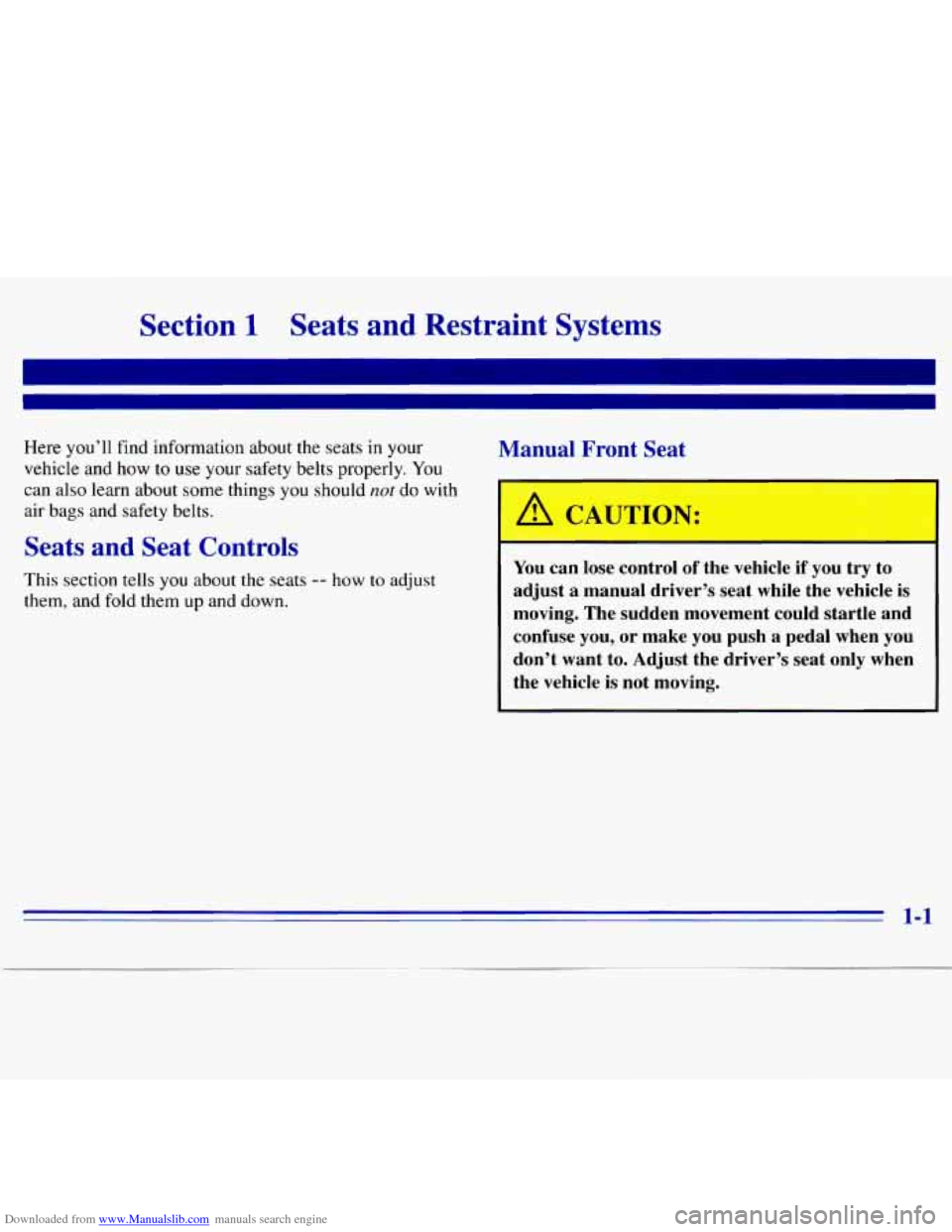
Downloaded from www.Manualslib.com manuals search engine Section 1 Seats and Restraint Systems
I
Here you'll find information about the seats in your
vehicle and how to use your safety belts properly. You
can also learn about some things you should
not do with
air bags and safety. belts.
Seats and Seat Controls
This section tells you about the seats -- how to adjust
them, and fold them up and down.
Manual Front Seat
You can lose control of the vehicle if you try to
adjust a manual driver's seat while the vehicle is
moving. The sudden movement could startle and
confuse you, or make you push a pedal when you
1 don't want to. Adjust the driver's seat only when
~ the vehicle is not moving.
1-1
Page 13 of 375
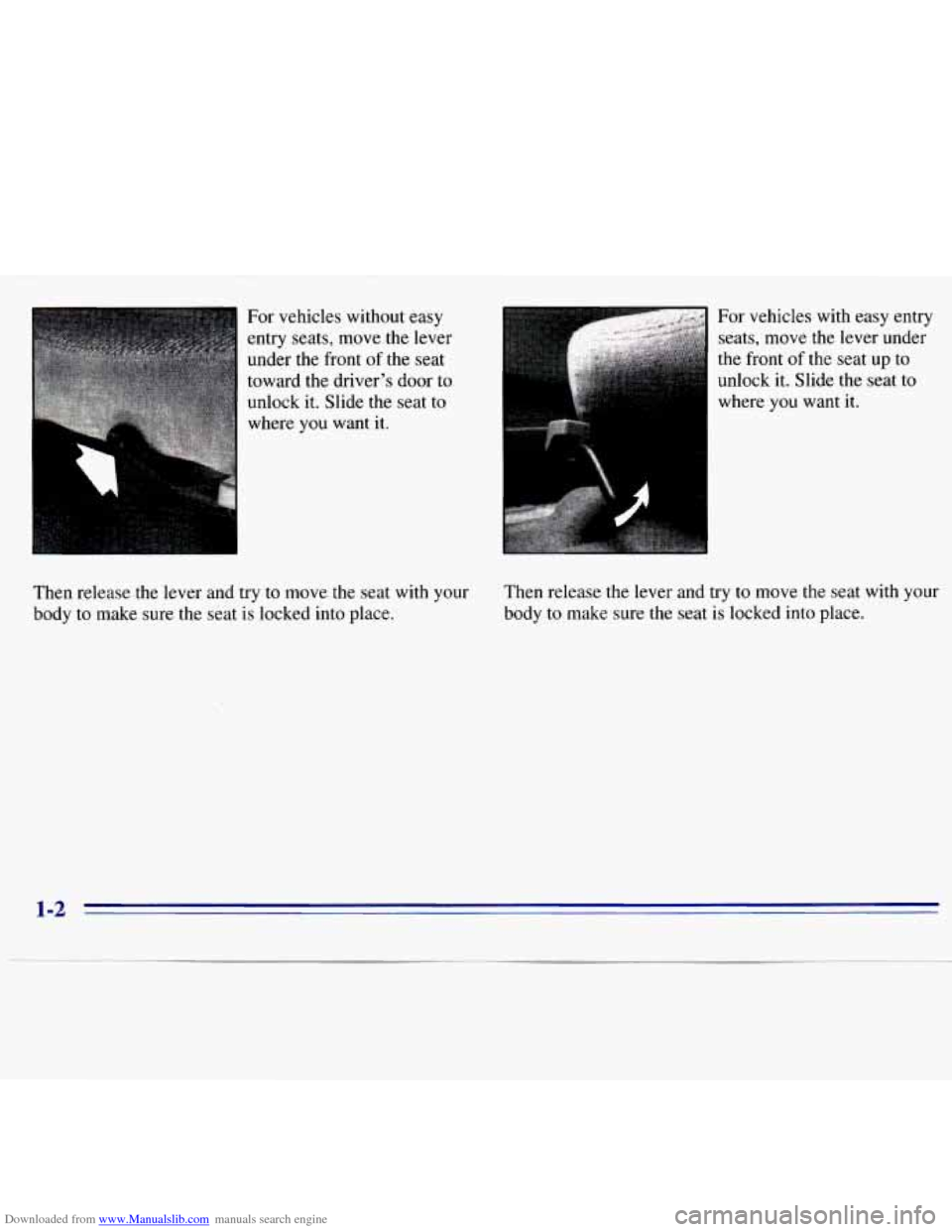
Downloaded from www.Manualslib.com manuals search engine For vehicles without easy
entry seats, move
the lever
under the front
of the seat I
toward the driver’s door to
unlock it. Slide the seat to
where you want it. For vehicles
with easy entry
seats, move the lever under
the front
of the seat up to
unlock it. Slide
the seat to
where you
want it.
Then release the lever and try to move the seat with your
body to make sure the seat is locked into place. Then release the lever and try
to move the seat
with your
body to make sure the seat is locked into
place.
Page 14 of 375
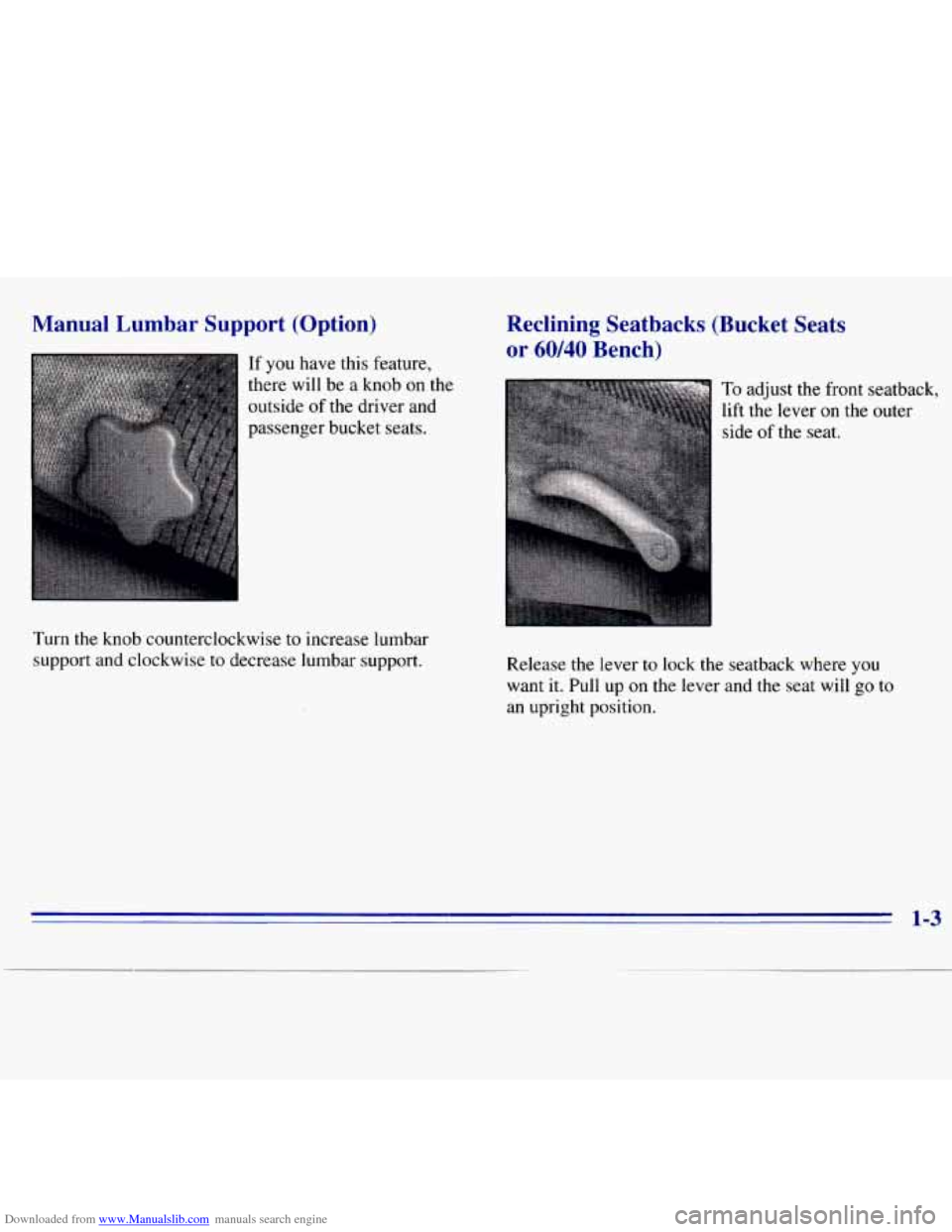
Downloaded from www.Manualslib.com manuals search engine Manual Lumbar Support (Option)
If you have this feature,
there will be a knob on the
outside
of the driver and
passenger bucket seats.
Turn the knob counterclockwise to increase lumbar
support and clockwise to decrease lumbar support.
Reclining Seatbacks (Bucket Seats
or 60/40 Bench)
To adjust the front seatback,
lift the lever on the outer
side
of the seat.
Release
the lever to lock the seatback where you
want
it. Pull up on the lever and the seat will go to
an upright position.
1-3
Page 15 of 375
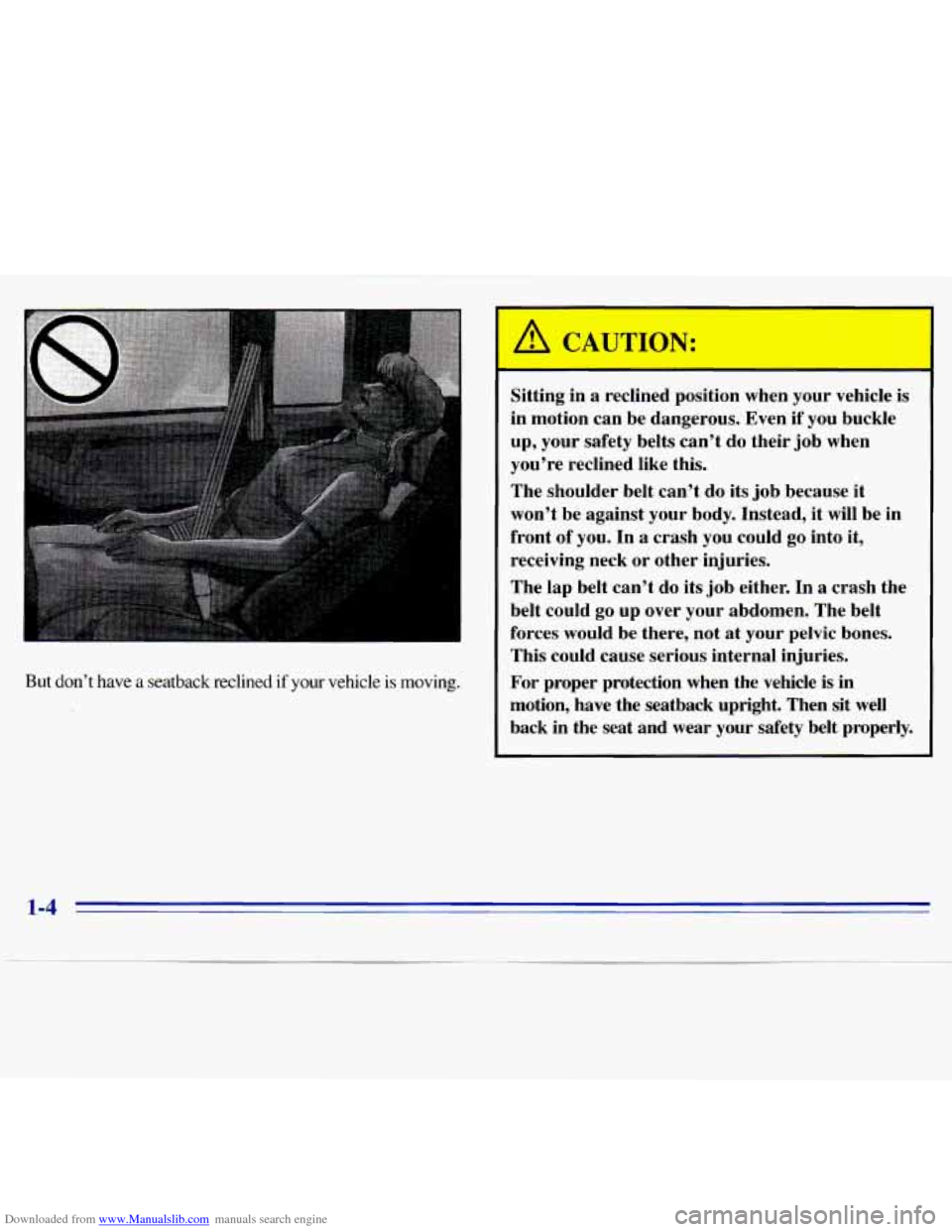
Downloaded from www.Manualslib.com manuals search engine But don’t have a seatback reclined if your vehicle is moving. Sitting in a reclined position when your
vehicle is
in motion can be dangerous. Even if you buckle
up, your safety belts can’t do their job when
you’re reclined like this.
The shoulder belt can’t do its job because it
won’t be against your body. Instead, it will be in
front of you. In a crash
you could go into it,
receiving neck or other injuries.
The lap belt can’t do its job either. In
a crash the
belt could go up over your abdomen. The belt
forces would be there, not at your pelvic bones.
This could cause serious internal injuries.
For proper protection when the vehicle is in
motion, have the seatback upright. Then sit well
back in the seat and wear your safety belt properly.
1-4
Page 16 of 375
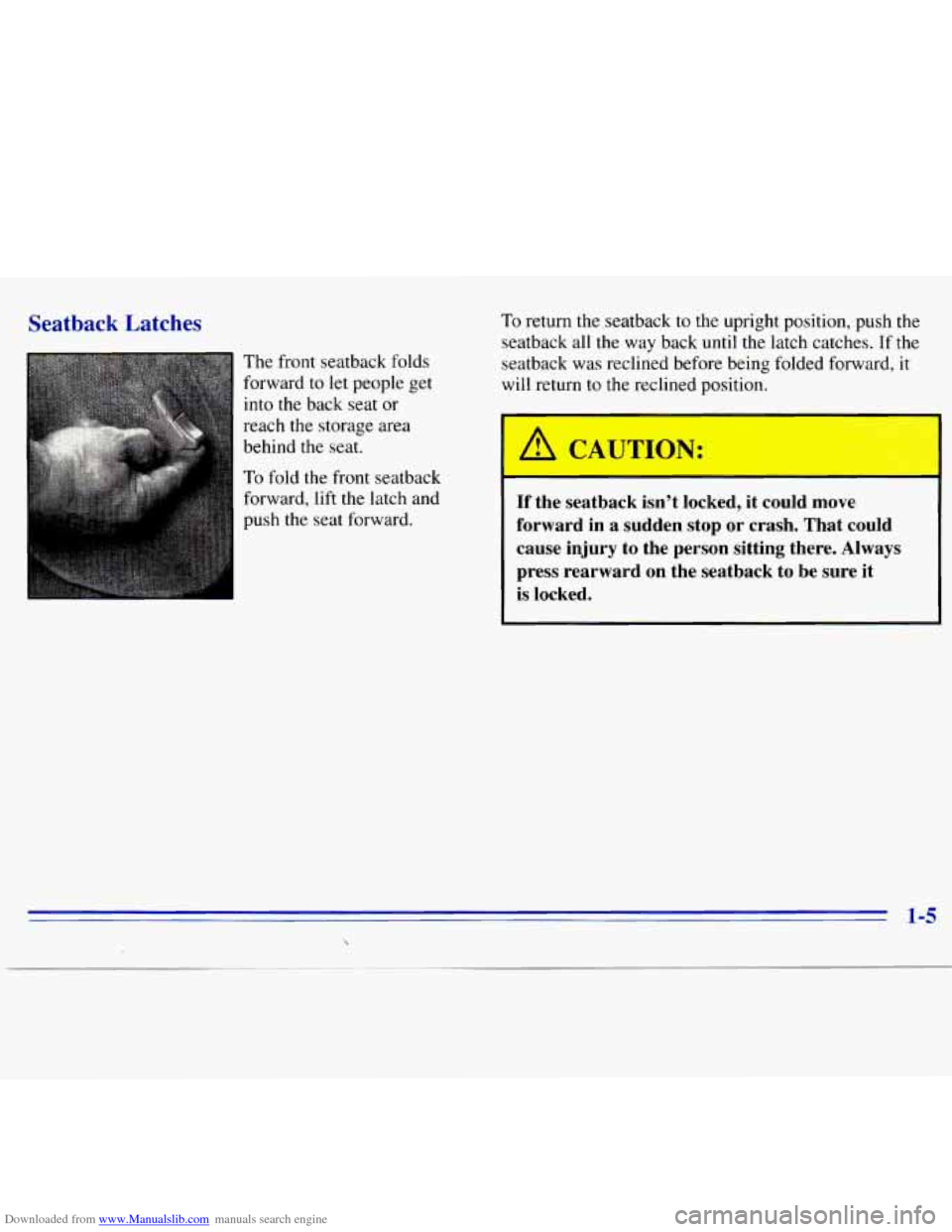
Downloaded from www.Manualslib.com manuals search engine Seatback Latches
The front seatback folds
forward to let people get
into
the back seat or
reach
the storage area
behind the seat.
To fold the front seatback
forward, lift the latch and
push the seat forward.
To return the seatback to the upright position, push the
seatback all the way back until the latch catches. If the
seatback was reclined before being folded forward, it
will return to the reclined position.
I-
A C WTION:
If the seatback isn’t locked, it could move
forward in a sudden stop or crash. That could
cause injury to the person sitting there. Always press rearward
on the seatback to be sure it
is locked.
Page 17 of 375
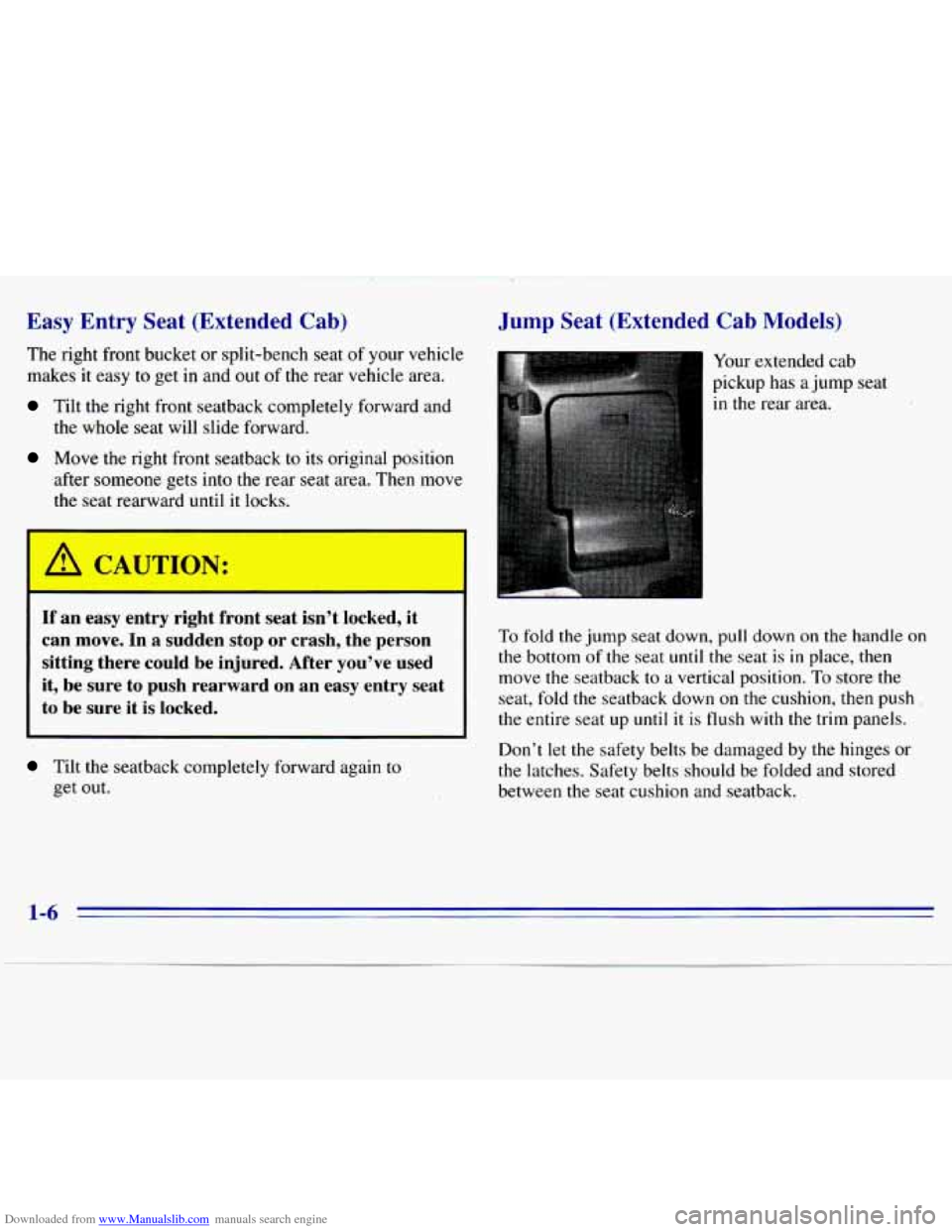
Downloaded from www.Manualslib.com manuals search engine Easy Entry Seat (Extended Cab)
The right front bucket or split-bench seat of your vehicle
makes it easy
to get in and out of the rear vehicle area.
Tilt the right front seatback completely forward and
the whole seat will slide forward.
Move the right front seatback to its original position
after someone gets into
the rear seat area. Then move
the seat rearward until it locks.
A CAUTION:
If’an easy entry right front seat isn’t locked, it
can move. In a sudden stop
or crash, the person
sitting there could be injured. After you’ve used
it, be sure to push rearward
on an easy entry seat
to be sure it is locked.
Tilt the seatback completely forward again to
get out.
Jump Seat (Extended Cab Models)
Your extended cab
pickup has
a jump seat
in the rear area.
To fold the jump seat down, pull down on the handle on
the bottom of the seat until the seat is in place, then
move the seatback
to a vertical position. To store the
seat, fold the seatback down on the cushion, then push
,
the entire seat up until it is flush with the trim panels.
Don’t
let the safety belts be damaged by the hinges or
the latches. Safety belts should be folded and stored
between the seat cushion and seatback.
Page 18 of 375
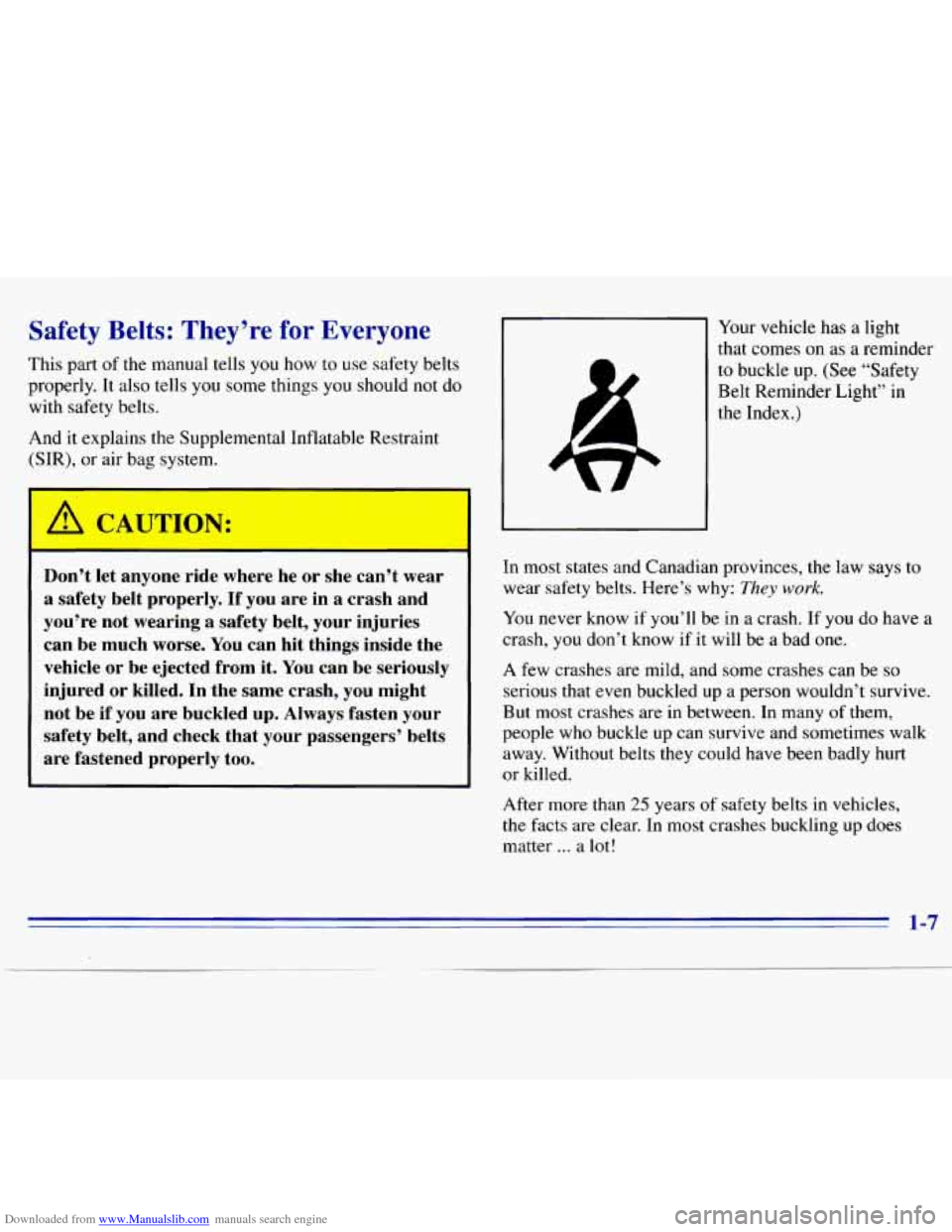
Downloaded from www.Manualslib.com manuals search engine Safety Belts: They’re for Everyone
This part of the manual tells you how to use safety belts
properly. It also tells you some things
you should not do
with safety belts.
And it explains the Supplemental Inflatable Restraint
(SIR), or air bag system.
L.
A CAUTION:
Don’t let anyone ride where he or she can’t wear
a safety belt properly. If you are
in a crash and
you‘re not wearing a safety belt, your injuries
can be much worse.
You can hit things inside the
vehicle or be ejected from it.
You can be seriously
injured or killed. In the same crash,
you might
not be
if you are buckled up. Always fasten your
safety belt, and check that your passengers’ belts
are fastened properly too. Your
vehicle has a light
that comes on as a reminder
to buckle up. (See “Safety
Belt Reminder Light” in
the Index.)
In most states and Canadian provinces, the law says
to
wear safety belts. Here’s why: They work.
You never know if you’ll be in a crash. If you do have a
crash,
you don’t know if it will be a bad one.
A few crashes are mild, and some crashes can be
so
serious that even buckled up a person wouldn’t survive.
But most crashes are in between. In many
of them,
people who buckle up can survive and sometimes walk
away. Without belts they could have been badly hurt
or killed.
After more than
25 years of safety belts in vehicles,
the facts are clear. In
most crashes buckling up does
matter
... a lot!
1-7
Page 19 of 375
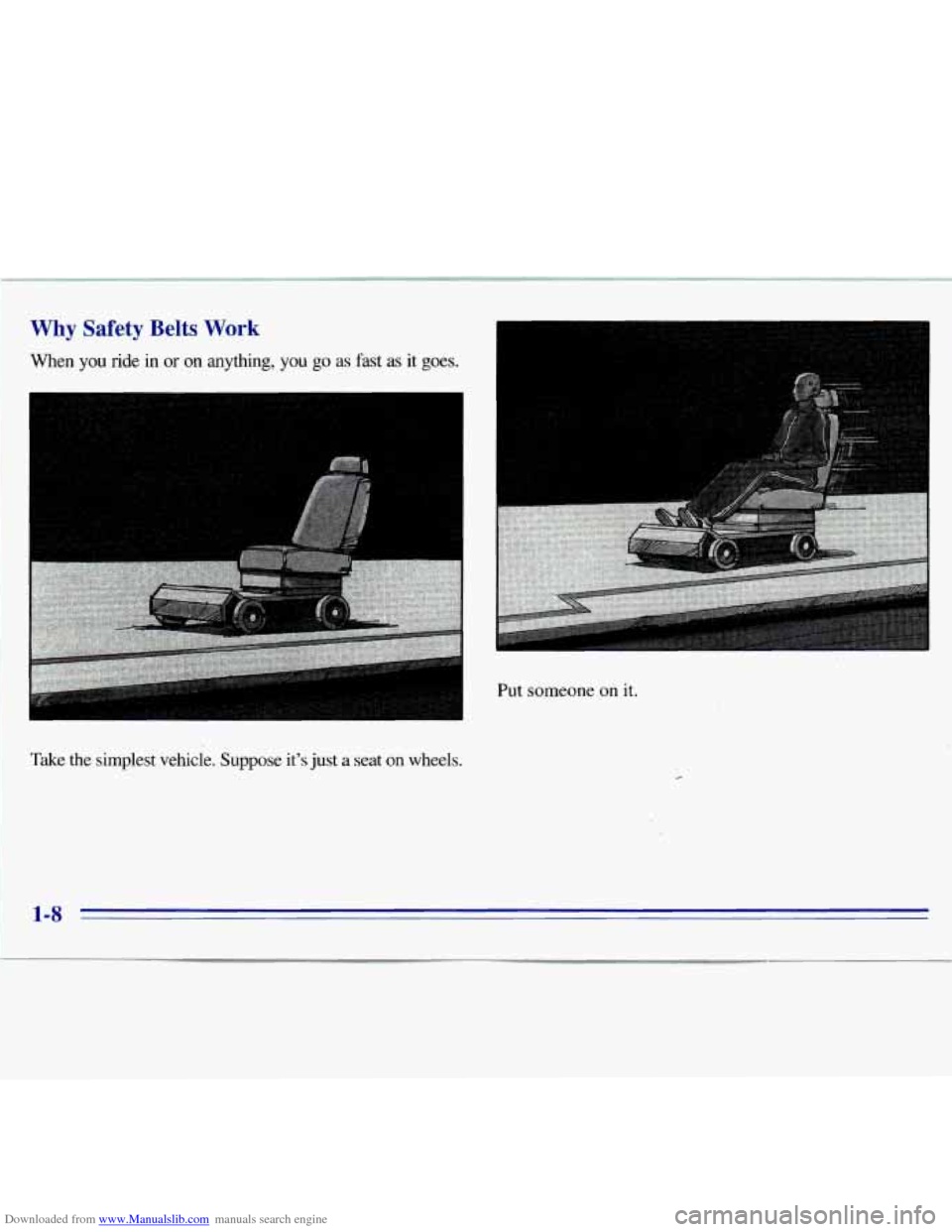
Downloaded from www.Manualslib.com manuals search engine Why Safety Belts Work
When you ride in or on anything, you go as fast as it goes.
Take the simplest vehicle. Suppose it’s just a seat on wheels. Put
someone
on it.
1-8
! 1
Page 20 of 375
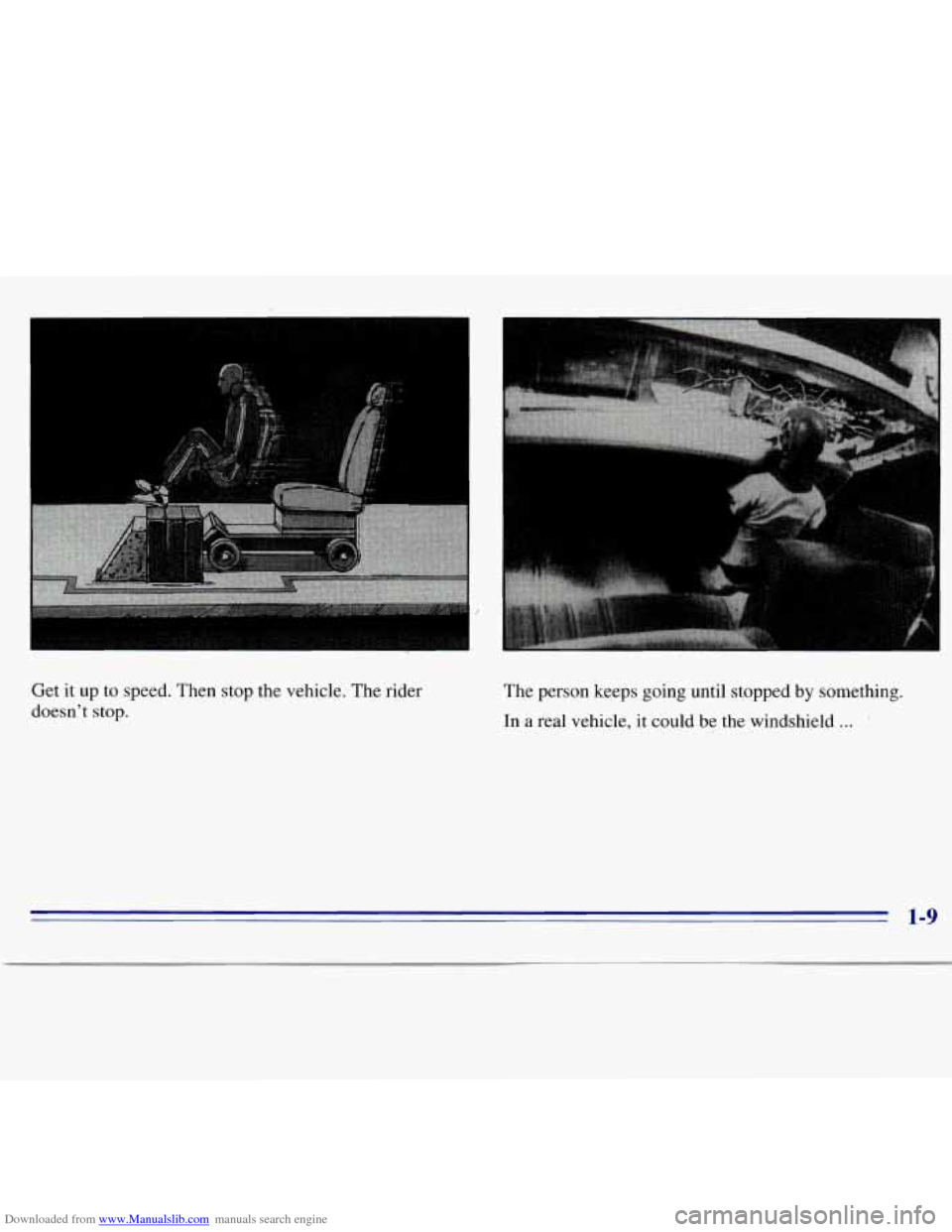
Downloaded from www.Manualslib.com manuals search engine 1
Get it up to speed. Then stop the vehicle. The rider
doesn’t
stop.
The person keeps going until stopped by something.
In
a real vehicle, it could be the windshield ...
1-9